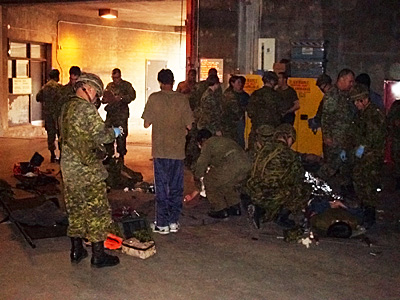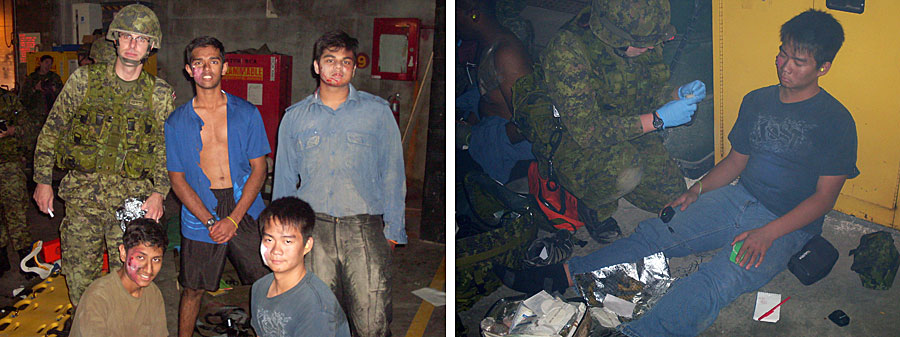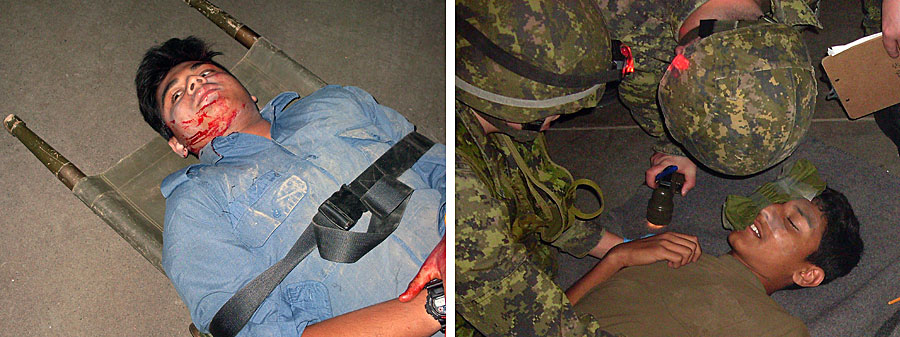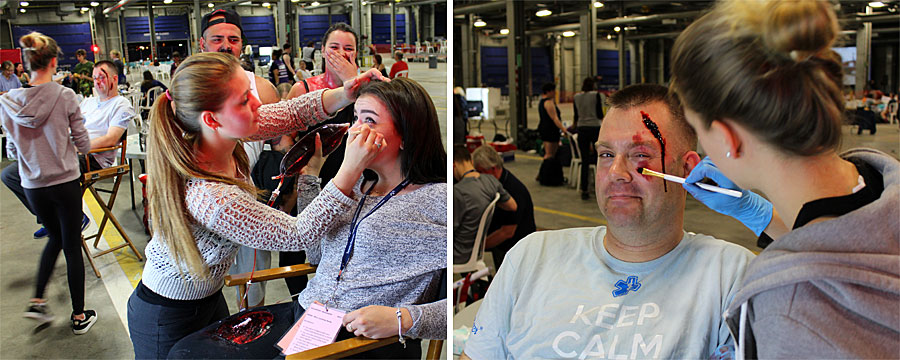
The 48th Highlander Army Cadets helped out with the medical
simulation during a friendly competition between several reserve
field ambulance units at Moss Park Armoury.

48th Highlanders
Royal Canadian Army Cadet Corps
First Aid Practice
This is the ongoing first aid practice page for the 48th Highlander Army Cadets at Moss Park Armoury. Check the calendar on the 48th cadets website for practice times and updates to the schedule.
During our 2015-2016 training year we participated in two major emergency medical exercises. The first was the St. Luke's Medical Skills Validation Exercise. Held at Moss Park Armoury on October 17th 2015 by 25 (Toronto) Field Ambulance, this exercise tested the skills of several reserve field amulance units in Ontario. The 48th Highlander Army Cadets created and performed as some of the simulated casualties.

The 48th Highlander Army Cadets as simulated casualties for the St. Lukes competition. The event took place in the gun park at Moss Park Armoury in Toronto.

Simulated casualties, played by 48th cadets, receive treatment from members of reserve medical units from Ontario.
The cadets also were casualty simulators for the large emergency exercise held at Toronto Pearson Airport on May 28th 2016. This exercise, called "Grand Slam", was one of the largest ever held in Toronto and involved the emergency services of not only the airport but of Toronto and Peel Regions as well. An exercise of this size is only held once every five years.

The 48th Highlander Army Cadets creating simulated casualties for Exercise Grand Slam held at Toronto Pearson Airport on May 28, 2016.
Pictured above are cadets (right) Cone (left) Pahlavi. Photos by Lt. J Courtland Elliott II, CD

Right: The simulated casualties wait in the shade of the plane wreckage. Left: The exercise begins with the arrival of airport fire trucks.
The cadets accompanied the simulated casuaties out onto the airport tarmac to apply last-minute makeup before the exercise started.
Photos by Lt. J Courtland Elliott II, CD
On our optional training night, Thursday November 10th, we were fortunate to meet with Adam Reading from Innovative Tactical Training Solutions (now North American Rescue Simulation). Mr. Reading was at Moss Park Armoury to demonstrate the TOMManikin to members of 25 Field Ambulance. The TOMManikin is a trauma manikin simulator designed for medical training in the military and in law enforcement organizations. It can realistically portray a wide range of wounds including blast injuries, gunshot wounds, and burns. The cadets, under Mr. Reading's direction, were able to learn a bit about the military medic's trade by watching various emergency medical procedures performed on the mannequin.

Left: The cadets get a quick briefing on the TOMManikin, a trauma simulator mannequin, from Adam Reading. Centre: Applying a tournique to themannequin's leg. Right: The cadets observe a simulated emergency cricothyrotomy performed on the TOMManikin
We now have a fully stocked medic's jump bag (training only) for cadet use and two Laerdal Rescusi Junior mannequins in our training inventory. These mannequins are designed for realistic CPR practice and are about the size of a 5 year old child. We expect to be adding additional training resources in the near future.
The cadets have two new first aid kits for use in garrison and on exercises. The Trauma Kit is for serious emergencies and contains supplies necessary to control life-threatening conditions such as severe external bleeds, cardiovascular emergencies, serious burns and other trauma. For minor emergencies such as small cuts, minor soft tissue injuries, sunburn, insect stings, poison ivy, splinters and similar injuries we have the Minor Emergencies Kit. The kits are separate to help keep the trauma supplies intact and organzied. If a serious emergency arises, the trauma kit must be immediately accessible and organzied so that the first aider can efficiently and effectively provide proper care to the casualty. When going on an exercise, always take both kits. In most cases only the Minor Emergencies Kit will need to be used but the Trauma Kit must be accessible for serious emergencies.
Can first aid training make a difference? Eli Beer, pictured above right in a TED video, began riding out in an ambulance at age 15. By the age of 17 he was organizing volunteers in Jerusalem into a rapid response team. Watch his full story by clicking on the video. His organization is called United Hatzalah
Are you new to first aid? Watch these short videos at World First Aid Day on the International Federation of Red Cross and Red Crescent Societies website. I've embedded one video to the left "Learn first aid. Be a hero." You should also watch the video at Rules of war (in a nutshell) by the International Committe of the Red Cross. This will give you a sense of the ethos of the Red Cross and Red Crescent societies, which were founded to give aid to those in need regardless of their nationality or ethnicity.
First Aid Practice
The pages posted here are outlines and notes for first aid practice.
- Special Operations Medicine The OFFICIAL Journal of the Special Operations Medical Association.
- TCCC stands for Tactical Casualty Combat Care; a skill now taught to many thousands of military personnel worldwide. TCCC brings advanced trauma life support skills to the battlefield. The three objectives of TCCC are: treat the casualty, prevent additional casualties, and to complete the mission.
- TCCC video on Youtube Introduction to Tactical Combat Casualty Care (TCCC). Excellent video, unfortunately YouTube has restricted the viewing.
- Wilderness & Environmental Medicine Journal Articles on caring for casualties in the wilderness.
- HOSA is an organization for health science students in high school and post secondary education.
- Emergency Scene Management (SFA/ITLS) Note: This document was updated on June 3, 2016, please download the latest edition. A two-page outline of Emergency Scene Management for both the St. John Ambulance Standard First Aid (SFA) and the International Trauma Life Support (ITLS) courses. This will be the standard for the 48th cadets. If you are going to summer cadet camp or loaded onto a First Aid Course, download and study this sheet ahead of time.
- Scene Survey - Part 1 Note: This document was updated on June 3, 2016, please download the latest edition. A detailed one-page outline of the Scene Survey as used in SFA and ITLS (called Scene Size-up in ITLS). Use this sheet for review. You might want to read Don't Be a Dead Hero: In some disasters, more rescuers die than original victims, by Bryce Hall. This is an well-written article about how to approach a dangerous situation when you are trying to help. Bystanders can also create a dangerous situation for potential rescuers: see Paramedics attacked while trying to save woman's life by A Current Affair Australia 2018 on YouTube
- Prehospital Casualty Data This sheet helps you to capture important patient data including vital signs and SAMPLE. Prints two up on a sheet of letter size paper (8.5" x 11").
- St. John Ambulance First Aid App Free for Android Phones, Blackberry and iPhones. This is from St. John Ambulance in the United Kingdom and uses UK and European First Aid Protocols. There may be differences between these protocols and the first aid protocols used by St. John Ambulance in Canada. Addendum: I've noticed one difference so far: the Recovery Position in the app is different from the current guidelines regarding arm position. The guidelines state to extend one arm above the head; the app states to extend the arm at right angles to the body. See Positioning the Ill or Injured Person - Updated in the 2015 American Heart Association and American Red Cross Guidelines Update for First Aid.
- Taking a Blood Pressure For those cadets that are interested, you can learn how to take a blood pressure. Blood pressure is an important vital sign which can tell the first responder about the condition of the casualty. Taking a blood pressure is excellent training for anyone wishing to go into any of the healthcare professions. The cadet practice medic's jump bag contains a new Sprague Rappaport Stethoscope and a manual blood pressure cuff that you can use for practice. Watch this video on taking blood pressure from the Ohio Academy of Family Physicians. The video is very well produced but does contain medical terminology which may make it slightly difficult for non-medical personnel to follow.
Hemmorage Control
The "C" in the ABC of first aid is for circulation. One important part of maintaining circulation is to stop bleeding. Below are several important references on methods of controlling bleeding (hemmorage). The gold standard for hemmorage control is direct pressure on the wound. This is simple and effective; all you need is your hand and some type of dressing. The cadet practice jump bag has several different types of pressure dressings including the Israeli Bandage, demonstrated in the video below.
- The Emergency Bandage
- Pocket Guide for Cold Conditions This 16-page guide prints to a small booklet size 8.5" x 5.5" that fits in a large pocket or your pack. Covers basic cold weather illness, prevention and treatment.
- Cold Injury Scenarios Four cold injury scenarios. Read the four scenarios and ask yourself: What would you do? 1 page. The discussion sheet follows.
- Cold Injury Scenarios - Discussion Four cold injury scenarios discussion. Before you read this download the scenario sheet (above), read it and ask yourself what you would do in these situations. 2 pages.
- The Khan Academy - Human Anatomy and Physiology A wonderful, simple, and thorough introduction to human anatomy and physiology. I suggest that you start with Meet the heart! by Rishi Desai MD. You can click on the video below to see "Meet the Heart!" Learn about the human body by watching videos online. Sign up and track your progress.
- Anatomy and Physiology An online, open-source (free) undergraduate level textbook for human anatomy and physiology. If you've gone through the videos at the Khan Academy and want more challenging material, you will find it in this text. Comprehensive (1358 pages) well-written and professionally illustrated, this book should be readable by high school seniors and above. You can download a low or high resolution PDF or read the textbook online. If you are participating in advanced first aid training, read:
- Chapter 1: An Introduction to the Human Body
- Chapter 4: The Tissue Level of Organization
- Chapter 16: The Neurological Exam
- Chapter 18: The Cardiovascular System: Blood
- Chapter 19: The Cardiovascular System: The Heart
- Chapter 20: The Cardiovascular System: Blood Vessels and Circulation
- 2015 American Heart Association and American Red Cross Guidelines Update for First Aid These are the current guidelines for first aid providers. This text may be difficult for non-medical personnel to follow due to the medical terminology but it does provide the evidence and logic behind why certain first aid procedures are recommended and other procedures are not.
- 2015 American Heart Association Guidelines Update for Cardiopulmonary Resuscitation and Emergency Cardiovascular Care These are the current guidelines for CPR (CardioPulmonary Resuscitation). Many of the recommendations are unchanged since the 2010 Guidelines.
- First Aid in armed conflicts and other situations of violence Although written for those working in a war zone, the same principles apply to wilderness first aid or anywhere definitive medical care is not immediately available. This book assumes you already have some basic first aid training.
- A Memory of Solferino Written by Henry Dunant, the founder of the Red Cross movement, this book describes the aftermath of the Battle of Solferino and the suffering of the injured soldiers. It was this book that led to the founding of the Red Cross and the creation of the Geneva Conventions.
- Autopsy Life And Death S01E01 - Circulation Watch anatomist Dr. Gunther von Hagens perform an autopsy while he explains the human circulatory system. 48 minutes total (5 parts).
Part 2
Part 3
Part 4
Part 5 - Gunther's ER- S1 Ep1 - Minutes From Death Dr. Gunther von Hagens shows how medical specialists and even first aiders can save the lives of trauma victims. 48 minutes.
- Gunther's ER- S1 Ep2 - Massive Blood Loss A continuation of the "Minutes from Death" video. 48 minutes.
- Autopsy: Emergency Room - Lesson 3 - Violent Impact See how traumatic injuries can affect the human skeletal system and the brain. 48 minutes.
Winter Training
First aid in cold conditions. Review these resources before you venture out into the cold.
Human Anatomy and Physiology
Anatomy is the study of the parts and structure of the human body. Physiology is the study of how those parts work together to keep us alive.
Texts
The following texts are for reference only if you wish to understand something in first aid in greater depth. You don't have to read them or understand them to be a competent first aider.
Videos
Note: These videos are still on YouTube and are of excellent quality, both education and production values. Unfortunately, YouTube has age-restricted these videos. All of the following popular videos feature anatomist Dr. Gunther von Hagens explaining the workings of the human body using cadavers and his plastinated models. These videos are intended for viewing by the general public; you don't need to have a background in medicine or biology to benefit from watching these videos. Again, excellent presentation and production values.
Copyright © by Barry M. Robinson, Toronto, Ontario, Canada | Privacy Policy
